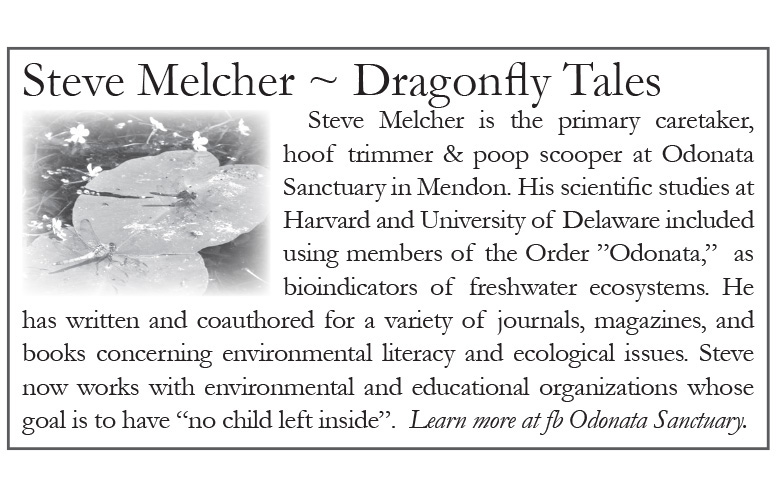Dragonfly Tales: Nature as a place of peaceful reprieve
by Steve Melcher –
 “In wildness is the preservation of the world.”
“In wildness is the preservation of the world.” 
~Henry David Thoreau
So spoke a true ‘Nature Boy’ over 100 years ago. Henry was someone who was seen as an ‘odd duck’, over educated and underemployed by his town’s folk. He was often seen sauntering through the woods of Lincoln and nearby Walden Pond where he built his now famous ‘cabin in the woods’. He sauntered seemingly with no direct purpose in mind, stopping here and there to observe a recently blooming flower or passing grasshopper. Sauntering is something that has become seldom seen in our swift superficial society. After all ‘saunter’ means to wonder in a slow and relaxed manner without hurry or effort. Here at Odonata Sanctuary, we are planning to build a replica of that cabin and other huts and hideaways of other nature writers. John Burroughs had his ‘Slabsides, still open to the public in West Park, NY. ‘The Shack’ is a rebuilt chicken coop along the Wisconsin River where Aldo Leopold crafted his conservation classic, A Sand County Almanac. Anne LaBastille’s wilderness cabin, famous worldwide for where she wrote the Woodswoman series of books, will be taken apart and transferred to The Adirondack Museum.
These special places are not just for nature writers. We all need a space to reconnect to nature…especially children. The IUCN (International Union for Conservation of Nature) World Conservation Congress provided dramatic support for the worldwide movement to re-connect children and nature—for their health and well-being and that of the Earth itself. The proposal states that children have a right to ‘equitable access’ to nature. Amazingly there are children near us in nearby cities that have never seen stars at night and only play on plastic ‘playgrounds’.
The IUCN adopted the resolution, “Child’s Right to Connect with Nature and to a Healthy Environment.” The resolution calls on IUCN’s government members, signers of the Jeju Declaration and NGOs to promote the Rights of the Child. Whew….all this and I just want to get my kid outside and have the ‘stink blown off him’.
Nature Deficit Disorder
What the Union, PCRM (Physicians Committee for Responsible Medicine), educators and many others including child psychologists are saying is that exposure to nature is as necessary to a child’s health as a healthy diet and exercise. A recent Yale study correlated children’s health with exposure to nature. In the study ‘The Nature of Americans’, Yale professor, Stephen R. Kellert, states: “The relationship of Americans and nature is changing.” Adults and children alike spend evermore time indoors, participation in outdoor activities beyond sports is stagnant or declining, and shifts in social expectations treat engagement with nature as a mere amenity. These trends pose a nationwide problem, since overwhelming evidence shows the physical, psychological, and social well being of humans depends on contact with nature. We’re finding a significant loss of exposure to nature with each generation. To many, Nature, ‘red in tooth and claw’, is to be feared and conquered. That fear has led to a separation from nature that is having dire consequences for our children. Children have an affirmative posture towards life. They have a natural curiosity. They are active beings who want to explore, experiment and build. As adults, all we need to do is provide the space and time for that exploration. We don’t need adults to show young children how to connect with nature. The space becomes the mediator. That space can be a local park or the tree in the backyard. Older children may want a mentor to further their natural curiosity about nature. We hope that our Odonata Sanctuary will become such a place in the near future.

Another finding that is shocking to me is the relationship between a child’s exposure to nature and feelings of loneliness. In their ‘Loneliness Experiment’ the BBC found that Loneliness is felt most intensely by young people. 40% of young people reported feeling lonely ‘often’ or ‘very often’, compared with 27% of the over 75s. The study concluded that ‘spending time in the natural environment – as a resident or a visitor – improves our mental health and feelings of wellbeing. It can combat loneliness and bind communities together.’ A pediatrician recently told me that loneliness has become as much of a factor of a child’s poor health as obesity and diabetes. 
Children that grow up exposed to nature, connected to nature, will have a greater chance of preserving the nature that they knew as children. If you expose your children to nature and allow those positive experiences to flourish, you create a future citizen who is more likely to preserve that experience through efforts to conserve wild areas. Children need nature as much as nature needs children. We owe our own story of our special place to our children and we owe them the preservation of ‘wildness’, for if ‘In Wildness is the preservation of the World’, who more deserves that preservation than our children: the future guardians of Earth?
You remember that special place you had as a sanctuary. Maybe down by the stream or even on the back step of your porch where you would ‘connect with nature’ while gazing at clouds or watching ants explore the concrete beneath your feet. I remember mine very well.
Give yourself permission to saunter and take a kid with you.

Further Reading:
The ‘Vitamin N Challenge’
Children and Nature Network (C&NN…not CNN) has created the ‘Vitamin N Challenge’ to bring together ideas for parents and practitioners to give their kids a healthy dose of vitamin N. There is even a book titled Vitamin N, which presents over 500 nature-oriented actions and activities. Vitamin N The Essential Guide to a Nature-Rich Life: 500 Ways to Enrich Your Family’s Health & Happiness by Richard Louv
The Walden Project: I’ll be writing a whole article on this wonderful endeavor, but for now check out: https://www.walden.org

